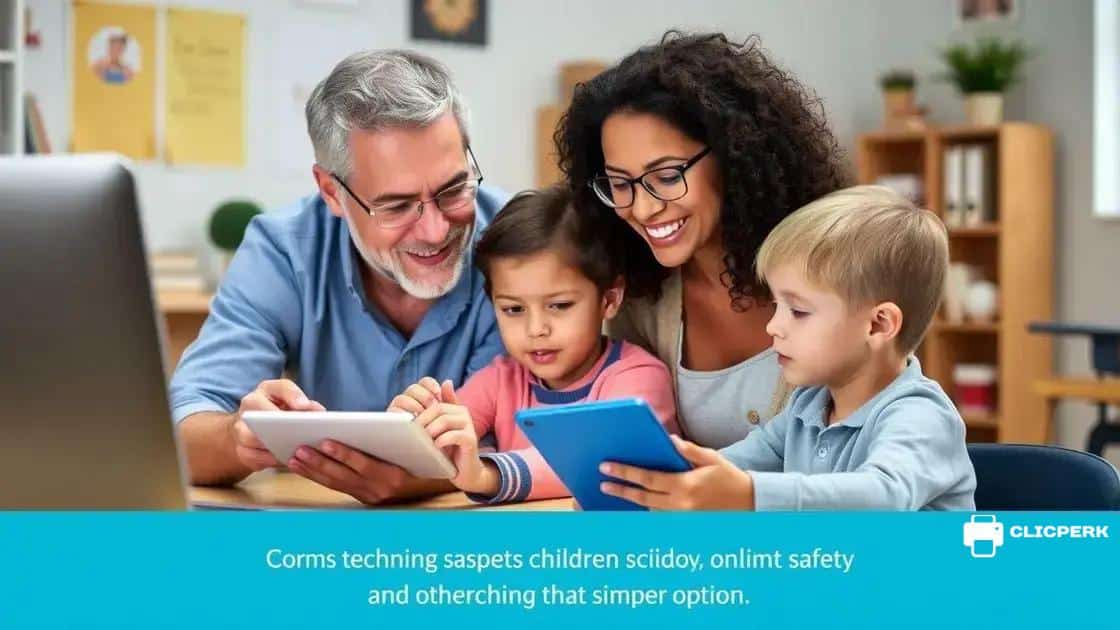Online safety for young students: keeping kids secure

Anúncios
Online safety for young students involves educating children about responsible internet use, teaching digital citizenship, and utilizing tools like parental controls to protect them from online threats.
Online safety for young students is more important than ever with the rise of digital technology. As children navigate the internet, understanding how to stay safe is crucial. What steps can we take to protect them?
Anúncios
Understanding online safety
Understanding online safety is crucial for young students in today’s digital landscape. With the internet being an integral part of their lives, teaching them how to navigate it safely is our responsibility.
Why Online Safety Matters
Many children are unaware of the potential dangers present online. It is essential to recognize that while the internet holds valuable resources and opportunities, it can also expose kids to risks.
By raising awareness about online safety, we can empower students to make informed decisions while surfing the web. One way to do this is through open discussions about their online experiences.
Anúncios
Key Elements of Online Safety
- Recognizing personal information and its importance
- Avoiding contact with strangers online
- Understanding phishing and other scams
- Utilizing strong passwords and privacy settings
Online safety involves various components that work together to protect children from harm. For instance, it’s vital for them to understand the importance of not sharing personal information like their full name, address, or school. Ensuring that they know whom they can trust online is equally important.
Moreover, parents and educators can help children identify phishing attempts and other online scams. Teaching kids to recognize suspicious links or emails helps reduce the likelihood of them falling victim to scams and identity theft.
Engaging with Children on Safety
It’s important to create an environment where young students feel comfortable discussing their online interactions. Encouraging them to share their concerns helps build strong communication lines between children and adults.
Incorporating practical lessons about online safety within classroom settings can further solidify their understanding of this crucial topic. By using real-life examples, educators can represent the potential dangers in an engaging way.
Ultimately, understanding online safety provides children with the tools they need to navigate the internet wisely and responsibly. Through awareness and dialogue, we can help them become informed digital citizens.
Common online threats to children
Common online threats to children can pose significant risks and lead to harmful situations. Understanding these threats is the first step in keeping young users safe.
Types of Online Threats
One major category includes cyberbullying. This can happen through social media, messaging platforms, or even in gaming communities. Victims of cyberbullying often experience emotional distress, which can affect their daily lives.
Another prevalent issue is the presence of online predators. These individuals often pretend to be someone they are not, seeking to exploit children’s trust. By engaging them in conversation and gaining their confidence, predators can manipulate young users into sharing personal information.
- Phishing Scams: These scams trick users into sharing personal information like passwords.
- Malware: This malicious software can harm devices and steal information.
- Inappropriate Content: Children can accidentally encounter harmful or explicit material.
Inappropriate content is another pressing concern. Kids might stumble upon sites that showcase violence or adult themes, which can be damaging to their development. It’s crucial for parents to monitor their children’s online activity and use filters to block such material.
Social Media Dangers
Many online threats arise from social media platforms. Kids often share too much of their personal lives, which might attract attention from the wrong people. Educating children about what information to share is essential in protecting their privacy.
Finally, online scams like phishing can put children at risk by tricking them into revealing personal data. Scammers use fake emails or messages to create a sense of urgency, prompting kids to act quickly without thinking.
By understanding these common online threats, parents and educators can help children navigate the internet safely. Awareness, open communication, and proper guidance are key to fostering a safer online environment.
Best practices for parents and teachers

Best practices for parents and teachers are essential in ensuring the online safety of children. By adopting effective strategies, adults can create a secure digital environment for young users.
Open Communication
One of the most effective ways to promote online safety is through open communication. Parents and teachers should encourage children to talk about their online experiences. This dialogue helps identify potential issues and provides an opportunity to address concerns.
Ask kids about the websites they visit, the games they play, and the people they interact with online. This not only builds trust but also keeps adults informed about their children’s online activities.
Establishing Rules
Setting clear rules regarding internet use is crucial. Guidelines can include:
- Limit screen time to encourage breaks.
- Specify which websites and apps are safe to use.
- Encourage children to use devices in shared spaces.
- Remind them about the importance of privacy.
Establishing these rules helps children understand the boundaries of acceptable online behavior.
Utilizing Technology
Parents and teachers can also use technology to enhance online safety. Employing parental controls, content filters, and monitoring software can help restrict access to inappropriate content. Regularly updating these tools ensures that young users are protected from emerging threats.
Educators can incorporate software that teaches digital literacy in their lessons. By equipping children with the skills to evaluate information critically, they will be better prepared to navigate the digital landscape.
Learning About Online Safety Together
It’s important for parents and teachers to stay informed about current online threats and trends. Participating in workshops or reading resources together can foster a shared understanding of online safety. By learning the dangers and best practices together, adults can better guide young users.
Ultimately, creating a safe online environment requires persistent effort and teamwork. By following these best practices, parents and teachers can significantly contribute to the safety and well-being of children in the digital world.
Tools and resources for online safety
Tools and resources for online safety are vital for parents, teachers, and children alike. These instruments help foster a secure digital environment, guiding users on how to navigate the internet safely.
Parental Control Software
Using parental control software can provide a significant layer of protection. These programs allow adults to monitor online activities, restrict website access, and set screen time limits.
Popular options include:
- Qustodio
- Net Nanny
- Kaspersky Safe Kids
- Circle with Disney
By implementing these tools, parents can ensure their children only access safe content.
Educational Websites
There are various educational websites dedicated to teaching online safety. These platforms offer interactive lessons, videos, and quizzes that engage children while educating them about potential digital dangers.
Examples include:
- CyberSmart
- Common Sense Media
- NetSmartz
These resources not only inform children but also encourage them to become responsible digital citizens.
Digital Citizenship Programs
Many schools implement digital citizenship programs that focus on educating students about their rights and responsibilities online. These programs often cover topics like privacy, cyberbullying, and appropriate online behavior.
Through workshops and classroom discussions, children gain the knowledge they need to protect themselves on the internet. Teachers play a significant role in facilitating these educational experiences.
Reporting Tools
It’s essential for children to know how to report inappropriate content or cyberbullying. Many social media platforms provide reporting features that allow users to flag harmful behavior. Educating children on how to use these tools can empower them to take action when facing online threats.
By understanding the available tools and resources for online safety, parents and teachers can significantly enhance the protection of children in the digital world. Equipping kids with this knowledge prepares them for safer internet use.
Teaching digital citizenship
Teaching digital citizenship is essential in helping students understand their roles and responsibilities in the online world. It emphasizes the importance of behaving ethically and respectfully while using the internet.
What is Digital Citizenship?
Digital citizenship refers to the norms of appropriate, responsible technology use. It encompasses various areas, such as online safety, privacy, and digital communication. Understanding what it means to be a good digital citizen helps children navigate the web more securely.
Key Principles of Digital Citizenship
There are several components to effective digital citizenship that educators should focus on:
- Respect: Encourage respect for others’ opinions and privacy.
- Responsibility: Teach the importance of taking responsibility for one’s online actions.
- Safety: Discuss the significance of protecting personal information online.
- Digital Literacy: Equip students with skills to critically evaluate online information.
By instilling these principles, students can become more aware of their online behavior and the impact it has on themselves and others. Understanding that their actions online have real-world consequences fosters a sense of accountability.
Effective Teaching Strategies
To teach digital citizenship effectively, educators can incorporate interactive lessons that engage students. Games, role-playing, and discussions about real-world scenarios help solidify these concepts. Engaging children in conversations about their online experiences invites them to share their perspectives and thoughts.
Using case studies of both positive and negative online behavior can illustrate the importance of digital citizenship. Discussing examples of cyberbullying can show students the harmful effects of disrespectful communication.
Involving Parents
It’s vital to involve parents in teaching digital citizenship as well. Providing resources and workshops for parents can help them support their children in practicing responsible online behavior. By working together, schools and families can build a strong foundation for children’s online safety.
Teaching digital citizenship prepares students to engage positively in the digital world. With guidance and support, they will grow into responsible digital citizens who can navigate the internet safely and respectfully.
In conclusion, ensuring online safety for young students involves collaboration between parents, teachers, and the students themselves. By teaching digital citizenship, using effective tools, and maintaining open communication, we prepare children to navigate the digital world safely. The key is to make learning about online safety engaging and interactive, empowering students to be responsible online users. Together, we can create a safer internet for everyone.
FAQ – Questions about Online Safety for Young Students
What is online safety?
Online safety refers to practices and tools that help protect children while they navigate the internet, ensuring they understand the risks and how to avoid them.
How can parents educate their kids about digital citizenship?
Parents can discuss online behavior, set rules, and encourage open communication about their children’s online experiences to foster responsible digital citizenship.
What tools are available to help ensure online safety?
There are various tools, such as parental control software, educational resources, and monitoring apps that can help protect children while they use the internet.
Why is teaching digital citizenship important?
Teaching digital citizenship empowers children to use the internet responsibly, understand their rights and responsibilities, and recognize the impact of their online behavior.





